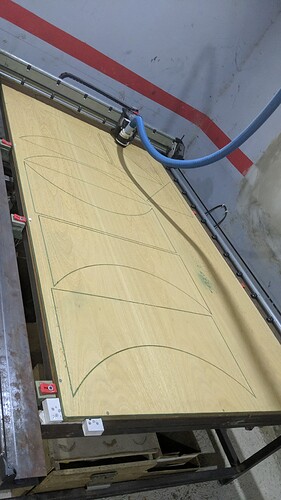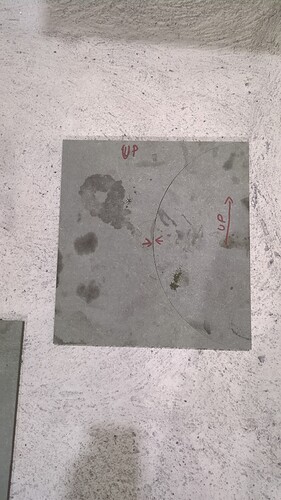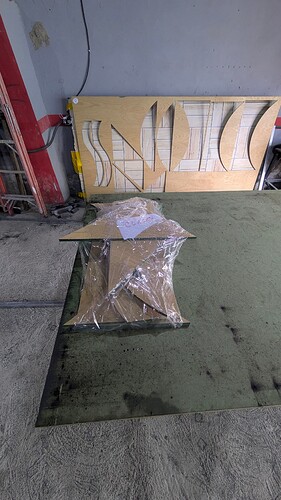This is very helpful. Just in reference to your cnc race-very impressive, and part of the reason I’m here if I’m being honest. What RPMs were you running there? I see in the calculator you linked it was at 18000rpm?
@vicious1 - Not to go too far into the weeds here on the mm/min vs mm/s debate, but I have always used mm/min as the base units, because that was expected for gcode feedrates (I’m still running Marlin on SKR Pro v1.2 - I suspect that there are still a few of us dinosaurs roaming the earth).
There have been many instances in the forum where users got caught on this, and were using mm/s for EstlCAM, and were complaining that their machine wasn’t moving, when in fact it was simply crawling along at an undetectable speed.
I didn’t check the wayback machine, but I thought that the V1E Docs once recommended using mm/min as the EstlCAM feedrate setting, although I see that it now recommends mm/s.
There are 2 different places you can set feedrate in Estlcam. One is for what it feeds the controller, which for the SKR or the Jackpot needs to be set to mm/min. The other spot is what you set your bits and all to, that is what Ryan suggests setting to mm/s. Estlcam will do the math to put out the correct units in the gcode.
If it doesn’t say I am not sure. I always start low and only bump it up if needed.
This happens automatically in your CAM package.
I may be beating a dead horse here, just want to make sure I’m moving in the right direction. The combo of Feed speed and RPM give you a chip load. You want this chip load to be in the ideal region because if not you are building too much heat in the bit and that destroys the cutting edge. Too small of a chip and the heat isn’t getting evacuated via the chips, too large of a chip and the bit is working too hard and making more heat. Chip evacuation also plays a role too - if you can’t get rid of the chips you can’t get rid of the heat. This plays into how many flutes and what size flute?
I’m guessing the reason that a single flute 1/8” bit is the ideal bit for these machines is the ideal chipload for that bit puts the feeds and RPMs right in the range these machines can handle. Moving to a 2+ flute means to get the ideal chip load we now have to move faster and may go beyond the speed capability of the machine. Same principle for a 1/4 bit, regardless of flute count.
I’m not saying the machines can’t handle the a multi flute 1/4” bit, but more saying to get the ideal chip load for tool life out of that bit, the machine can’t physically reach the speeds it needs to, so tool life will be reduced because there will be more heat going into the bit as a function of not cutting a big enough chip to evacuate heat.
Too small of a bite and you start to rub the material and not cut.
Too large of a bite and the load is too high and you get poor tolerances or broken bits.
In wood there is a HUUUUUGE range of values that work. Too slow it burns, too fast you get broken bits.
The issue you ran into is you made the first 1mm of you endmill dull. That renders the entire endmill basically useless.
The RPM your spindle turns (how often the cutting edge sees the material face) and the material you are cutting (how large the ideal chip size is and if it fits out of the evacuation flute) dictates how many flutes you should have.
I start everyone on a 1/8” bit becuase they have a tiny load. Very easy for the machine to handle. It is an ideal starter endmill.
Secondary to that most people can live with the internal corner radius it leaves.
1/4” single flutes are actually closer to what the machines can typically handle with ease. I have driven a 1/2” dovetail bit at 3/4” depth straight through maple in a deep slot. The machine can handle a lot, but the closer you get to the load limit of the machine, the more perfect your CAM settings have to be. You need to master a 1/8” single flute before you move up.
No. Speed has nothing to do with it unless you are talking about lasers. CNC machines only have load limits in terms of material removal.
The RPM range of our spindles dictates we use a single flute endmill in wood. We have 18,000-30,000 rpm “spindles”. Super fancy machines use 1,000 to 5,000 RPM spindles. They need more flutes so the cutting face sees the same number of interaction with a cutter at a given feedrate.
You are asking for some very specific things so I am very intentionally inserting “in wood” into these answers. Every material, machine build, spindle being used, exact type of cutter, type of cut being performed is drastically differnt. You are asking me to make broad general statements, which is fine, but know that is not how this works.
You are focused on heat, that is not really an issue in wood, it is in plastic so you don’t melt the material, and it is in heat so you don’t ruin your endmill. So yes heat is a factor but not for the reason you thinking. If you over heat a endmill in wood your settings are so far wrong you are not even close. I wood you have a window of acceptable feedrates of about ±300mm/s, in metal that can be more like ±5mm/s. (when our feedrates are wrong we can adjust by changing the rpm of the spindle, making note and adjusting next time).
Just make more test cuts and this all starts become very clear, you can hear and see when things are good or bad.
I apologize, I’m for sure going down the rabbit hole here and likely confusing myself even further. I have more time to think and type than actually doing, so there is a fair amount of trying to convince myself where to start. This leads to wanting specific generalizations, which is an oxymoron.
Most of this doesn’t come intuitively to me, and I suppose if it was intuitive most people could do it. I’m attempting to find a baseline for where to start instead of going all over the place with speeds and feeds (as I have done for the past couple months and feel like I know nothing more than when I started). I know there are starting points in the milling basics page, but then it becomes wildly confusing after that. For example in the basics page we start at 1mm DOC and 8mm/s (I understand now this is kind of a factory acceptance test - does the machine move in the right way etc etc and isn’t really made to be a good starting point…I think). But then you have the cnc race you talked about where you are getting into 12mm DOC and 50+mm/s. Obviously neither situation is ideal but that is a massive range of speeds and cut depths.
For example - the pieces I cut earlier at 8.3mm/s and 4-6mm doc slotting: to me this seems very slow, but I get I’m chasing zeros here. I previously cut some knife handles, a fairly simple 3d shape where I roughed using adaptive clear from fusion with a 1/4” single flute taking anywhere from 50% stepover and 10mm DOC to 1mm DOC in Walnut and Ironwood at 30mm/s, a bore operation for a 6mm hole using a 1/8” single flute and a finishing pass both at 30mm/s, and then finally a parallely pass with a 1/8” ballnose taking 0.25 mm passes at 60mm/s and these turned out fantastic. dimensionally almost perfect. But then I move over to plywood and it seems I can only run 8 or so mm/s reliably so I’m trying to make sense of it all.
As you’ve said before testing will answer these questions, but it feels like my testing is just a bunch of random pieces being cut with no rhyme or reason and perhaps I’m not learning from it what I should.
Thank you for spending the time trying to educate me on this. As you obviously know there is an insane level of complexity involved.
Furthermore Ryan I understand the position I inadvertently put you in by requesting specific information that you can’t really give - sorry about that.
I don’t think it does for anyone….but after a handful of cuts it starts to become very clear. I can talk about settings all day but trying a few yourself only takes a couple minutes.
Material removal = rpm, depth of cut, feedrate, number of flutes.
The easiest one to change while it is in motion is RPM. If you have to slow down your RPM to get a good cut, next time you can increase the feedrate some. If you need to speed up your RPM, you might be going a little too fast.
Almost any setting will cut wood, the more ideal your cut the longer the tool lasts, that is the bottom line of it all.
The next steps are deeper passes until you hit about 3x diameter, then speed up your feed rate. Don’t over think it.
Woods you can go much deeper, plastics that is a good depth, metals maybe a little less. Generally.
It all works, there is not really a perfect cut. When you hit a speed you are satisfied with stay there. I personally cut pretty slow. I just want my project to cut the first time. I don’t care about saving 7 minutes on my cut, or for that matter that most things are ±0.02mm.
It is very slow. but it works every time.
Crap plywood is full of Glue, good plywood has much less glue. Still you should be able to go much faster with a single flute upcut bit.
You are describing two totally different kind of cuts, the first fancy ones have two different finishing passes you are describing, then cutting plywood, I assume slotting, no roughing no .3mm stepover ball nose….who cares about sub mm accuracy in plywood.
If you want every single job to have sub mm accuracy, that is what it takes. Roughing and at least one finishing pass (some call it a spring pass).
The reason there is not a page full of settings is the variables are insane and infinite. You are asking for the holy grail of CNC, the perfect settings page. Even if I said, this router, with this endmill, in this material….the endmill might be new, might be dull, the wood might have a knot or a pocket of sap or glue, or the MDF you have is super dense…or wet. There is just no such thing as a perfect recipe.
Just take your time, learn your material and cutters. Test cut, test cut testcut. Eventually you will not have to do so many test cuts. I test cut, still…10 years in, in all materials other than wood. Most times I use MDF so I can wing it pretty easily. IF I do anything else, like a carve in maple…..I do a test cut. Shop temp, humidity, endmill sharpness, router brush life, hold downs, Some days it feels like everything matters, in a familiar material….it is simple and nothing matters becuase it just always works.
Wood is kinda confusing because of how dam easy it is.
When you cut plastic or metal, you HAVE to learn your settings or it simply will not work. You either snap a bit pushing to hard, or snap a bit from welding/melting it into the material.




